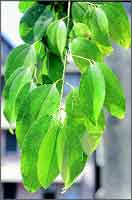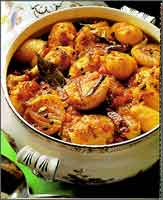


|
Bay Leaves The attractive spear-shaped leaf with its earthy aroma is useful for both decoration and cooking in Indian cuisine. |
|
Although indigenous to Asia, bay leaves have adapted themselves to other parts of the world, and as a result cuisines all over use bay leaves. In India, bay leaves are an important part of the Mughlai and Raj cuisine, as both the Moghuls and the British familiarised themselves with the bay leaf and used them innovatively in their cuisines. In India the bay leaf constitutes an important part of the garam masala. Bay leaves are used chiefly in meat and rice dishes. They are also added to hot oil before the main ingredient as frying releases their sweet perfume. But in the West, bay leaves are added to fish dishes, meats, vegetables, soups, stews, marinades, sauces and even custards.
The attractive spear-shaped leaves and its earthy aroma make bay leaves useful for both decoration and cooking.
|

Home Page
About the mag
Subscribe
Advertise
Contact Us
 The Indian bay leaf, or tej patta as it is more popularly known, does the job of a thousand spices. Add a couple of bay leaves to any cuisine and notice the richness that it imparts. Bringing together other flavours, giving them depth, and adding richness is what bay leaves do best. However, you will never find them as the main flavour in a dish. They are added to food for the scent they impart.
The Indian bay leaf, or tej patta as it is more popularly known, does the job of a thousand spices. Add a couple of bay leaves to any cuisine and notice the richness that it imparts. Bringing together other flavours, giving them depth, and adding richness is what bay leaves do best. However, you will never find them as the main flavour in a dish. They are added to food for the scent they impart. Bay leaves are available dried, either whole or in pieces. Dried Indian bay leaves are dull green in colour and quite brittle. They have a woody aroma, quite like that of cinnamon, and a slightly pungent intense flavour. However, the very intense flavour of fresh bay leaves tend to mellow when dried for a few days. Crinkle the leaves just before using them to release their flavour. Old, dried leaves tend to lose their flavour so be sure to replenish your supply often. The surest way to test a bay leaf is to crinkle the leaves and savour the pungent, spicy fragrance that is the bay leaf's signature.
Bay leaves are available dried, either whole or in pieces. Dried Indian bay leaves are dull green in colour and quite brittle. They have a woody aroma, quite like that of cinnamon, and a slightly pungent intense flavour. However, the very intense flavour of fresh bay leaves tend to mellow when dried for a few days. Crinkle the leaves just before using them to release their flavour. Old, dried leaves tend to lose their flavour so be sure to replenish your supply often. The surest way to test a bay leaf is to crinkle the leaves and savour the pungent, spicy fragrance that is the bay leaf's signature.